Biosurfactants Market Size
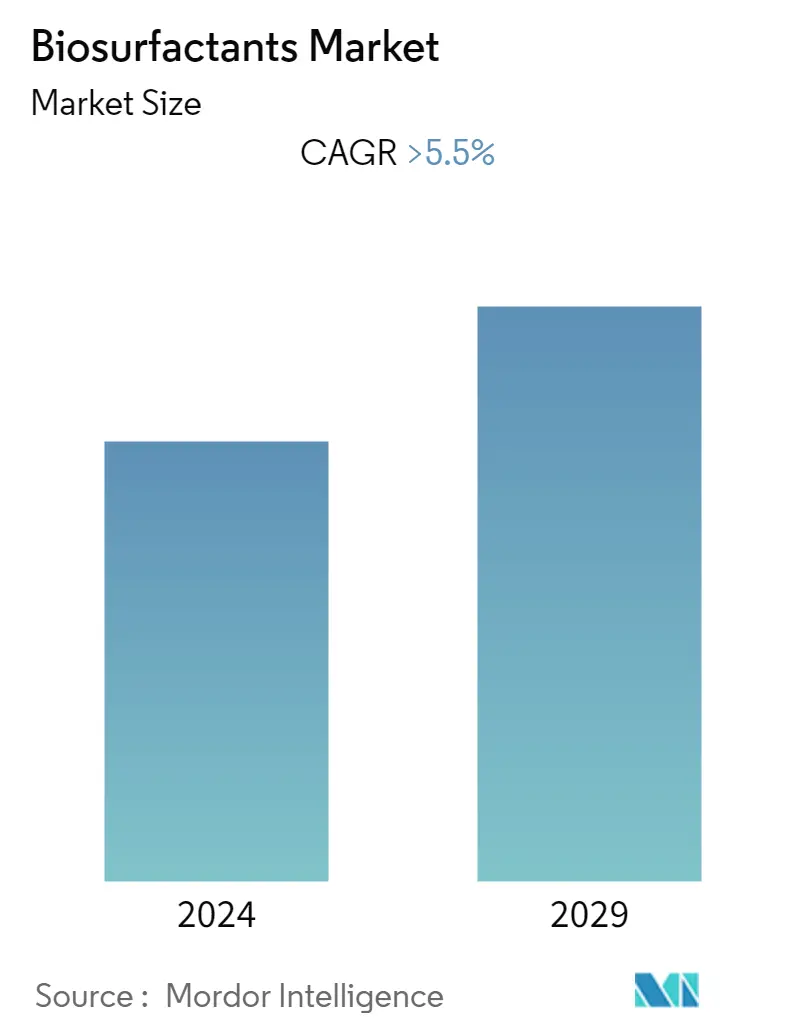
| Study Period | 2019 - 2029 |
| Base Year For Estimation | 2023 |
| CAGR | 5.50 % |
| Fastest Growing Market | Asia Pacific |
| Largest Market | Europe |
| Market Concentration | High |
Major Players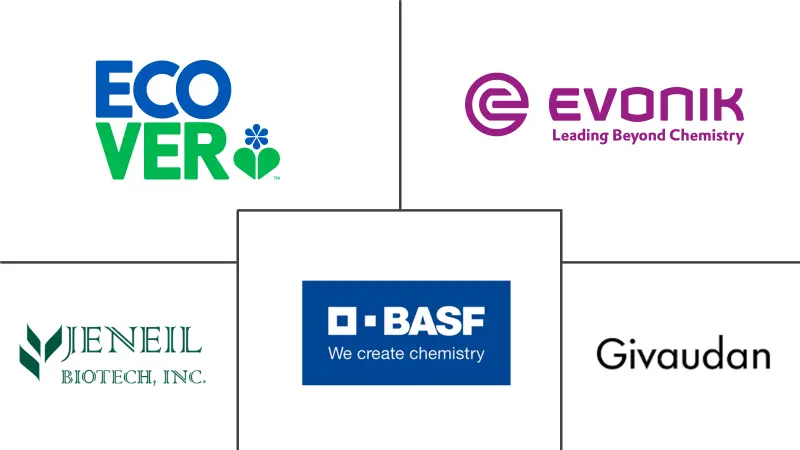
*Disclaimer: Major Players sorted in no particular order |
Biosurfactants Market Analysis
The biosurfactants market is projected to register a CAGR of over 5.5% during the forecast period.
The COVID-19 pandemic negatively impacted the market in 2020. However, consciousness regarding personal hygiene and clean surroundings has increased in the current situation, stimulating the demand for personal and household cleaning products and enhancing the market growth of biosurfactants.
- Over the short term, the growing personal care industry in Asia-Pacific and rising consumer inclination toward using bioproducts are expected to drive the market's growth.
- High production costs are likely to hinder the market's growth.
- Growing innovation in the production methods of the biosurfactants will optimize the overall cost of their products which is further expected to stage lucrative growth opportunities for the growth of the market studied.
- The Europe region is expected to dominate the market. However, Asia-Pacific is likely to witness the highest CAGR during the forecast period.
Biosurfactants Market Trends
This section covers the major market trends shaping the Biosurfactants Market according to our research experts:
Detergents and Industrial Cleaners Segment is Expected to Dominate the Market
- Surfactants serve a critical role in the formulation of laundry and household cleaning products. Chemical surfactants, softeners, oxidizing agents, and different enzymes are among the constituents of modern detergents.
- Furthermore, surfactants are all synthetically made and pose a threat to young aquatic life. The search for eco-friendly characteristic alternatives for compound surfactants in garment cleaners has been re-energized by the growing public awareness of environmental problems and risks associated with compound surfactants.
- Biosurfactants are preferable over chemical surfactants because of their low toxicity, the endurance of temperature and pH fluctuations, and high biodegradability. Above all, they have the advantage of being able to be made from renewable resources. Biosurfactant structures, such as glycolipids, lipopeptides, and polymeric surfactants, can be generated depending on the microbe and carbon and nitrogen sources employed. The interaction with the residue may differ depending on the structure of the biosurfactant.
- Biosurfactants, such as Cyclic Lipopeptide (CLP), are stable across a wide pH range (7.0-12.0) and do not lose their surface-dynamic properties when heated to high temperatures. They demonstrate excellent emulsion creation capability with vegetable oils, as well as outstanding resemblance and strength to commercial clothes cleaners, indicating that they should be considered in a clothing cleansers strategy.
- According to the Industry Association for Personal Care and Detergents e. V (IKW), revenues from laundry detergents and cleaning products in Germany accounted for EUR 5,092 million (~USD 6,024.60 million) in 2021, compared to EUR 5,246 million (~USD 5,989.49 million) in the previous year.
- According to the Bureau of Labor Statistics, average annual expenditure on soaps and detergents per consumer unit in the United States accounted for USD 80.49 in 2021, compared to USD 75.53 in 2020.
- All such factors are likley to significantly impact the demand for the studied market.
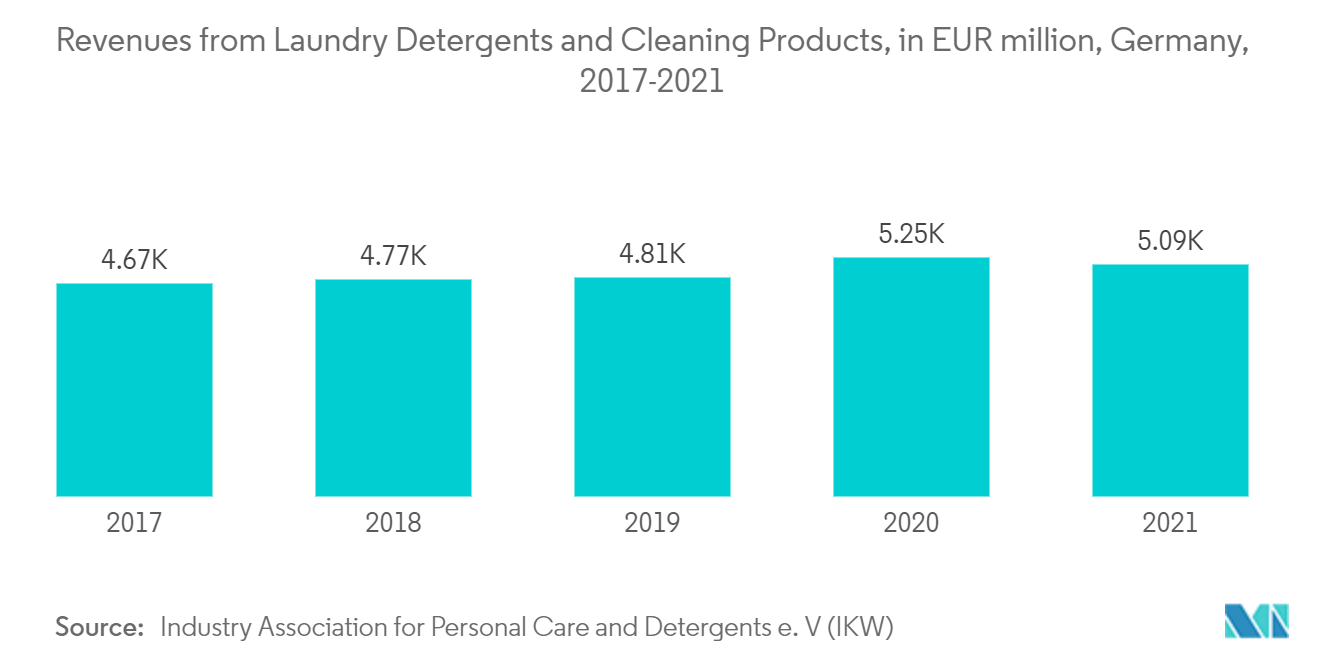
Europe is Expected to Dominate the Market
- The European region accounted for the largest share of the regional market for biosurfactants. Owing to the presence of the largest consuming countries, such as Germany, the United Kingdom, France, and Italy, the demand for biosurfactants in the region is growing at a significant rate.
- Germany's population has increased over the years, and awareness regarding personal care and hygiene is high. Hence, the usage of soaps and detergents is high. This, in turn, is expected to increase the usage of surfactants over the forecast period.
- The output from the German chemical industry is essential in various products, which include soaps, detergents, cosmetics, etc. More than 60 manufacturers of washing, care, and cleaning agents are present in the country.
- According to the VKE - Association of Marketing Companies for Cosmetic Products e. V, year-on-year revenue development in the cosmetics industry in Germany accounted for 0.4% in 2021, compared to -9% in 2020.
- The market for the soap and detergent manufacturing industry in the United Kingdom is dynamic, and the industry is known for strong product innovation, as the manufacturers compete to retain consumer interest.
- According to the Office for National Statistics in the United Kingdom, the revenue generated through the manufacturing of soap and detergents and cleaning and polishing preparations is likely to reach about USD 6,131.81 million by 2023.
- The oil and gas industry plays a vital role in the growth of the country's economy. Although the United Kingdom is a mature petroleum province, the offshore oil industry in the country proved its resilience in the face of one of the most severe oil price downturns in recent years. The offshore oil industry in the United Kingdom is shallow-water-based, and deep-water accounts for a limited share.
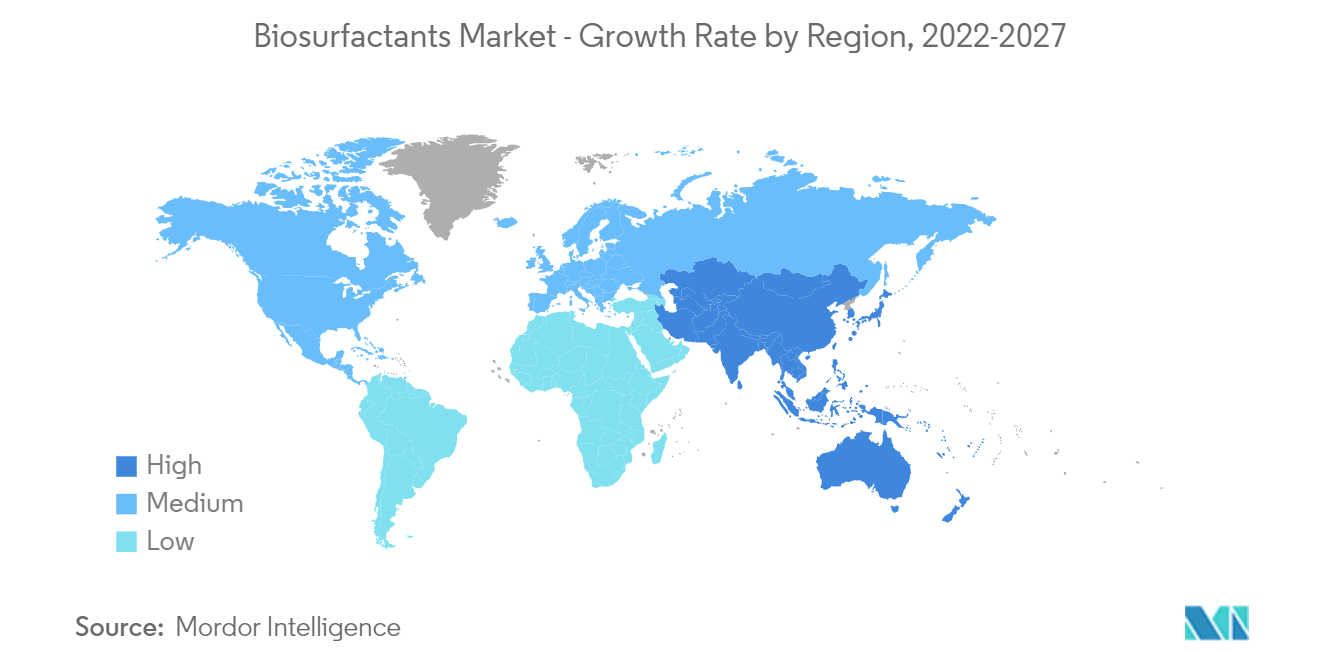
Biosurfactants Industry Overview
The biosurfactants market is consolidated, with the top five players holding a significant of market share. Some key players in the biosurfactants market (in no particular order) include Evonik Industries AG, BASF SE, Ecover, Jeneil, and Givaudan, among others.
Biosurfactants Market Leaders
-
BASF SE
-
Evonik Industries AG
-
Givaudan
-
Ecover
-
Jeneil
*Disclaimer: Major Players sorted in no particular order
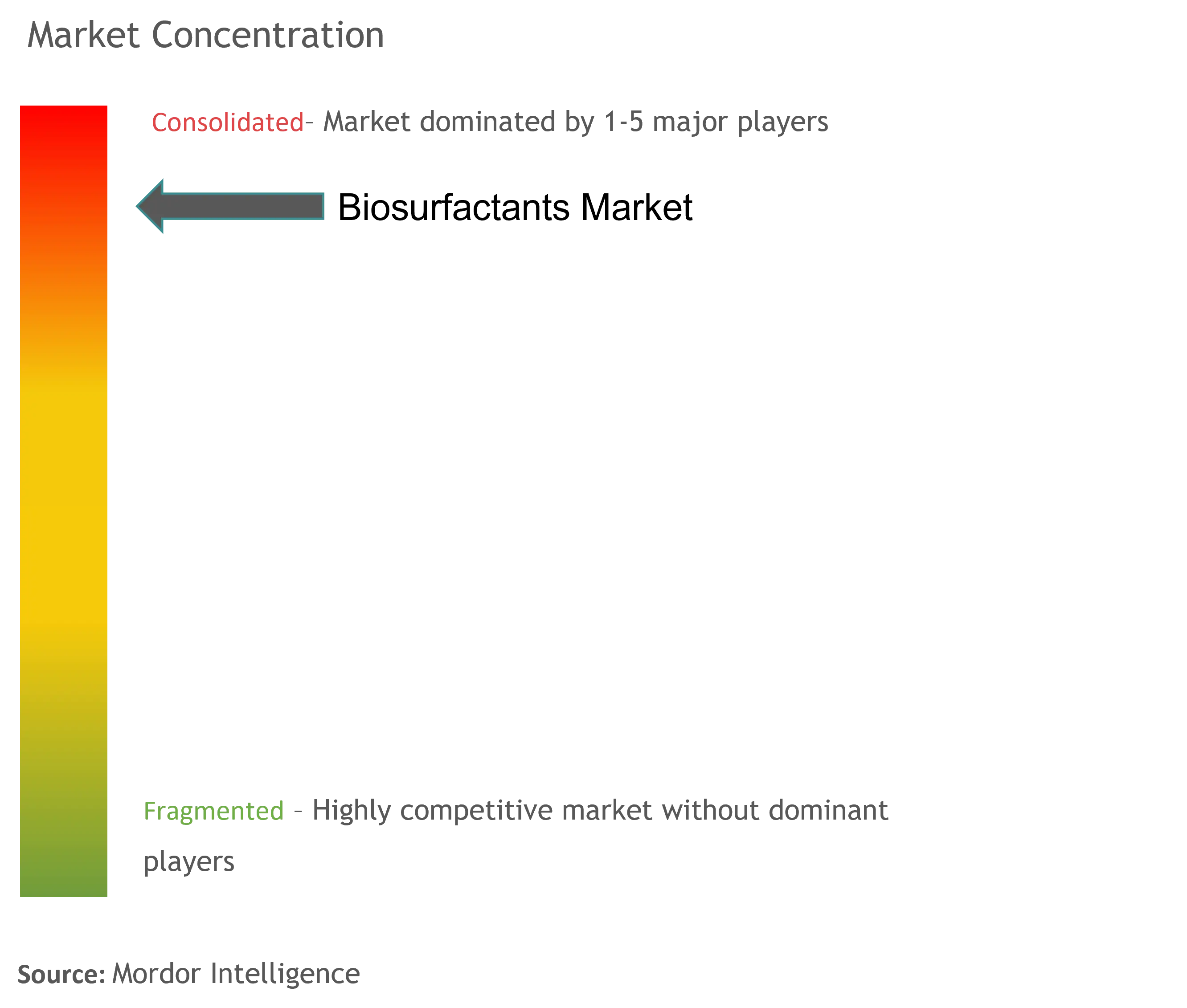
Biosurfactants Market News
- In June 2022, Evonik Industries AG started constructing a commercial rhamnolipid production facility in Slovenská Ľupča, Slovakia. With this new biosurfactant plant, the company has plans to become a pioneer of good quality, sustainable biosurfactants.
- In March 2022, BASF SE announced that its part Care Creations had developed Plantapon Soy, a bio-based anionic surfactant derived from soy protein that offers many sustainability benefits to the personal care and cosmetics industry.
Biosurfactants Market Report - Table of Contents
1. INTRODUCTION
- 1.1 Study Assumptions
- 1.2 Scope of the Study
2. RESEARCH METHODOLOGY
3. EXECUTIVE SUMMARY
4. MARKET DYNAMICS
-
4.1 Drivers
- 4.1.1 Growing Personal Care Industry in Asia-Pacific
- 4.1.2 Rising Consumer Inclination Toward the Use of Bioproducts
-
4.2 Restraints
- 4.2.1 High Production Cost
- 4.2.2 Other Restraints
- 4.3 Industry Value Chain Analysis
-
4.4 Porter's Five Forces Analysis
- 4.4.1 Bargaining Power of Suppliers
- 4.4.2 Bargaining Power of Consumers
- 4.4.3 Threat of New Entrants
- 4.4.4 Threat of Substitute Products and Services
- 4.4.5 Degree of Competition
5. MARKET SEGMENTATION (Market Size in Value)
-
5.1 Product Type
- 5.1.1 Glycolipid (Rhamnolipids, Trehalolipids, and Sophorolipids)
- 5.1.2 Phospholipids
- 5.1.3 Surfactin
- 5.1.4 Lichenysin
- 5.1.5 Polymeric Biosurfactants
- 5.1.6 Other Product Types
-
5.2 Application
- 5.2.1 Detergents and Industrial Cleaners
- 5.2.2 Cosmetics (Personal Care)
- 5.2.3 Food Processing
- 5.2.4 Oilfield Chemicals
- 5.2.5 Agricultural Chemicals
- 5.2.6 Textiles
- 5.2.7 Other Applications
-
5.3 Geography
- 5.3.1 Asia-Pacific
- 5.3.1.1 China
- 5.3.1.2 India
- 5.3.1.3 Japan
- 5.3.1.4 South Korea
- 5.3.1.5 ASEAN Countries
- 5.3.1.6 Rest of Asia-Pacific
- 5.3.2 North America
- 5.3.2.1 United States
- 5.3.2.2 Canada
- 5.3.2.3 Mexico
- 5.3.3 Europe
- 5.3.3.1 Germany
- 5.3.3.2 United Kingdom
- 5.3.3.3 France
- 5.3.3.4 Italy
- 5.3.3.5 Spain
- 5.3.3.6 Rest of Europe
- 5.3.4 South America
- 5.3.4.1 Brazil
- 5.3.4.2 Argentina
- 5.3.4.3 Rest of South America
- 5.3.5 Middle-East and Africa
- 5.3.5.1 Saudi Arabia
- 5.3.5.2 South Africa
- 5.3.5.3 Rest of Middle-East and Africa
6. COMPETITIVE LANDSCAPE
- 6.1 Mergers and Acquisitions, Joint Ventures, Collaborations, and Agreements
- 6.2 Market Ranking Analysis
- 6.3 Strategies Adopted by Leading Players
-
6.4 Company Profiles
- 6.4.1 AGAE Technologies LLC
- 6.4.2 Biotensidon GmbH
- 6.4.3 Cognis Care Chemicals (BASF SE)
- 6.4.4 Ecover
- 6.4.5 Evonik Industries AG
- 6.4.6 Givaudan
- 6.4.7 GlycoSurf LLC
- 6.4.8 Jeneil
- 6.4.9 Kaneka Corporation
- 6.4.10 Logos Technologies (Stepan Company)
- 6.4.11 Saraya Co. Ltd
- 6.4.12 Synthezyme LLC
- 6.4.13 TeeGene Biotech
- 6.4.14 TensioGreen
- 6.4.15 WHEATOLEO
- *List Not Exhaustive
7. MARKET OPPORTUNITIES AND FUTURE TRENDS
- 7.1 Innovation in Feasible Commercial Production of Bio-surfactants
Biosurfactants Industry Segmentation
Biosurfactants are surface compounds produced by microorganisms, including bacteria, yeast, and fungi. It has the potential to substitute synthetic surfactants because of its low toxicity and specificity property. The biosurfactants market is segmented by product type, application, and geography. By product type, the market is segmented into glycolipids, phospholipids, surfactin, lichenysin, polymeric biosurfactants, and other product types. By application, the market is segmented into detergents and industrial cleaners, cosmetics (personal care), food processing, oilfield chemicals, agricultural chemicals, textiles, and other applications. The report also covers the market size and forecasts for the biosurfactants market in 16 countries across the major regions. For each segment, the market sizing and forecasts have been done based on revenue (USD million).
| Product Type | Glycolipid (Rhamnolipids, Trehalolipids, and Sophorolipids) | |
| Phospholipids | ||
| Surfactin | ||
| Lichenysin | ||
| Polymeric Biosurfactants | ||
| Other Product Types | ||
| Application | Detergents and Industrial Cleaners | |
| Cosmetics (Personal Care) | ||
| Food Processing | ||
| Oilfield Chemicals | ||
| Agricultural Chemicals | ||
| Textiles | ||
| Other Applications | ||
| Geography | Asia-Pacific | China |
| India | ||
| Japan | ||
| South Korea | ||
| ASEAN Countries | ||
| Rest of Asia-Pacific | ||
| Geography | North America | United States |
| Canada | ||
| Mexico | ||
| Geography | Europe | Germany |
| United Kingdom | ||
| France | ||
| Italy | ||
| Spain | ||
| Rest of Europe | ||
| Geography | South America | Brazil |
| Argentina | ||
| Rest of South America | ||
| Geography | Middle-East and Africa | Saudi Arabia |
| South Africa | ||
| Rest of Middle-East and Africa |
Biosurfactants Market Research FAQs
What is the current Biosurfactants Market size?
The Biosurfactants Market is projected to register a CAGR of greater than 5.5% during the forecast period (2024-2029)
Who are the key players in Biosurfactants Market?
BASF SE, Evonik Industries AG, Givaudan, Ecover and Jeneil are the major companies operating in the Biosurfactants Market.
Which is the fastest growing region in Biosurfactants Market?
Asia Pacific is estimated to grow at the highest CAGR over the forecast period (2024-2029).
Which region has the biggest share in Biosurfactants Market?
In 2024, the Europe accounts for the largest market share in Biosurfactants Market.
What years does this Biosurfactants Market cover?
The report covers the Biosurfactants Market historical market size for years: 2019, 2020, 2021, 2022 and 2023. The report also forecasts the Biosurfactants Market size for years: 2024, 2025, 2026, 2027, 2028 and 2029.
Biosurfactants Industry Report
The global market for bio-based surfactants is segmented by product type, application, and geography. The market size and forecasts for biosurfactants are provided in terms of revenue for all segments. The industry report covers various product types such as glycolipids, phospholipids, surfactin, lichenysin, polymeric biosurfactants, and other product types. Applications include detergents and industrial cleaners, cosmetics, food processing, oilfield chemicals, agricultural chemicals, textiles, and other applications.
The market analysis highlights the significant growth rate of the bio-based surfactants market. Industry reports provide valuable industry information and insights into industry trends. The market forecast suggests a positive market outlook and market growth.
The market review includes a detailed industry analysis, offering a comprehensive industry overview. Market segmentation is crucial for understanding different market dynamics. The market value is expected to increase, driven by the demand in various applications.
Industry research and industry statistics are essential for understanding the market leaders and market data. The industry size and industry sales are projected to rise, reflecting the growing adoption of bio-based surfactants.
Market predictions and market outlook indicate a favorable industry outlook. The report example and report pdf provide detailed insights and are available for download. Research companies can benefit from the market trends and market forecast provided in the report.
In summary, the bio-based surfactants market is poised for substantial growth, with industry reports offering a thorough understanding of market dynamics, market segmentation, and market value. The industry analysis and industry research provide a solid foundation for market predictions and market review.



